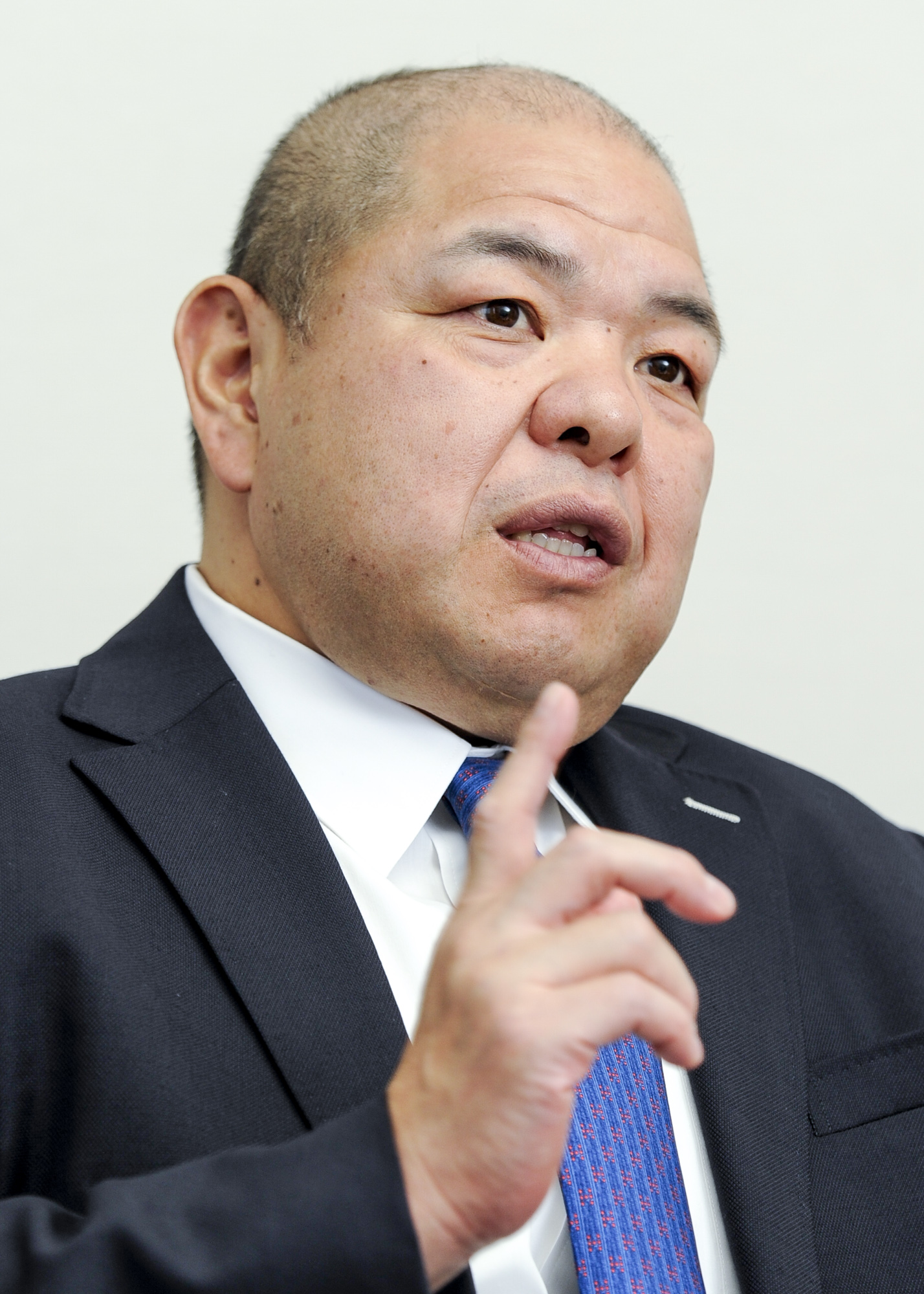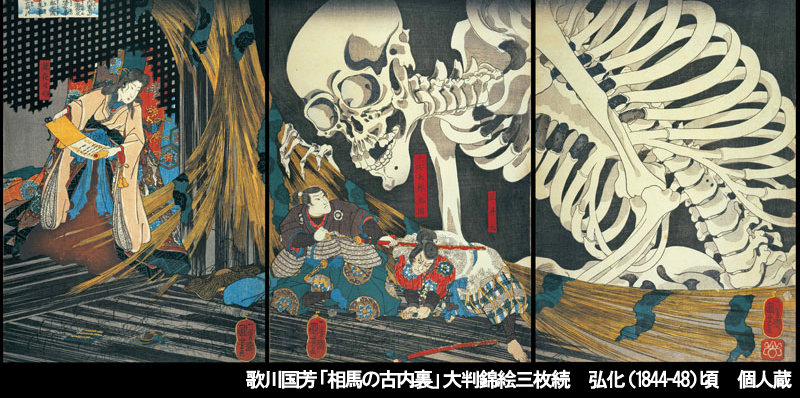The Master of Special Effects – The Legacy of Tsuburaya Eiji ― In conversation with Ooka Shinichi, President of Tsuburaya Productions
Explosions crash and bang as Godzilla or another monster destroys the city…
Ultraman shoots Spacium Rays to take down another monster…
The best thing about watching special effects movies is that they always shock and surprise you.
Tsuburaya Eiji was known as the master of special effects, but in what ways is his DNA being kept alive today? We take a look back and share in the recollections of Ooka Shinichi, former cameraman and current President of Tsuburaya Productions.
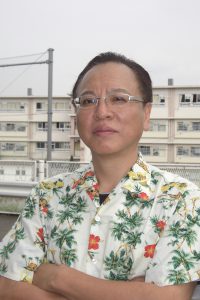
Shiraishi Masahiko, movie researcher, screenwriter and director
There is one man in particular who was known as the master of special effects. In 1936, he developed the screen process (rear projection, a system involving positioning a screen behind the actors then projecting scenery onto the screen from behind) for the first time in the movie industry on the set of a German co-production called Atarashiki Tsuchi (The Daughter of the Samurai). He later recreated the aerial attack on Pearl Harbor on a miniature set for the movie Hawaii Mare Oki Kaisen (The War at Sea from Hawaii to Malaya) in 1942, before bringing to life a 50-meter tall monster and laying waste to Tokyo in the 1954 movie Godzilla. That man was Tsuburaya Eiji.
After Godzilla, movies on which Tsuburaya handled special effects technology became a gold mine for Toho and ended up supporting the entire company. Although Tsuburaya’s special effects movies covered a wide range of areas, including science fiction, war and fantasy, the genre in which they proved most popular was kaiju (monster) movies. Tsuburaya brought to life one monster after another at the company’s request, including Rodan, Mothra and King Ghidorah, and established kaiju movies as a new genre in Japan.
In 1963, Tsuburaya established Tsuburaya Special Effects Productions and installed himself as President, so that he could take on challenges in new genres such as television commercials. That company is now Tsuburaya Productions. Ultra Q aired for the first time on January 2, 1966, followed by Ultraman on July 17, the same year. As well as bringing in high viewing figures, they also sparked a kaiju boom, and laid the foundations for the rest of the Ultraman series, which is still going to this day. Television had given rise to a master of special effects.
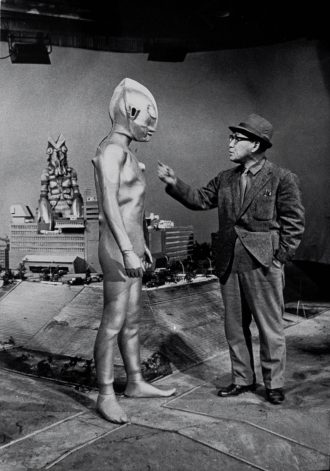
Tsuburaya Eiji (right) and Ultraman in the special effects studio, with Alien Baltan in the background
© TSUBURAYA PRODUCTIONS
Tsuburaya Eiji (1901–1970)
Special effects director Tsuburaya Eiji was born in Fukushima Prefecture. He enrolled at Nippon Flying School in 1916, before going on to study at Tokyo Denki University in 1917. He entered the movie industry in 1919, aged just 18. After spells at the likes of Shochiku Kyoto Studios, in 1939 he joined Toho Tokyo Studios, where he worked on special effects for war movies such as Hawaii Mare Oki Kaisen (The War at Sea from Hawaii to Malaya). The ban on public service led to Tsuburaya leaving Toho and going freelance in 1948. That same year, he set up Tsuburaya Special Effects Laboratory in Soshigaya. Godzilla was released in 1954 and became an unprecedented hit. Following the establishment of Tsuburaya Special Effects Productions in 1963, Ultra Q began airing on television in 1966, sparking a huge “kaiju (monster) boom” throughout Japan. Tsuburaya continued to work on the Ultraman series after that point. The name of the company was changed to Tsuburaya Productions in 1968. Tsuburaya passed away at his second home in Ito on January 25, 1970, at the age of 68.
The current President of Tsuburaya Productions is former cameraman Ooka Shinichi. Having had a hand in countless productions at Tsuburaya, including Ultraman Taro and Ultraman 80, in the 1990s he also worked as special effects director on series such as Ultraman Tiga and Ultraman Dyna.
Kawakami Kenji, Arikawa Sadamasa, Takano Koichi, Sagawa Kazuo, Kawakita Koichi… They are all legends who have made a tremendous contribution to the development of special effects of Japan, and they were all directly influenced by Tsuburaya. One thing that all five men have in common is that they started out in the camera department. Special effects depend on the process of taking something that cannot be achieved through live action filming, and using technology to bring it to life on film. In other words, one of the qualifications you need to oversee special effects is an understanding of how film works. Tsuburaya believed that members of the camera department were ideally suited, because this was something that had seeped into every fiber of their being. Tsuburaya himself started out in the camera department, from the days of silent movies when cinematic technology was still in its infancy. He was a pioneer in the art of “trick photography,” having been one of the first in Japan to introduce techniques such as glass work and double exposure. In that sense, Ooka Shinichi, it would be fair to say that you have undoubtedly taken on the DNA of Tsuburaya Eiji.
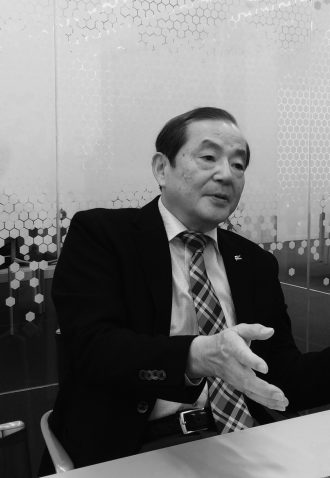
Ooka Shinichi, President of Tsuburaya Productions, Director of photography. Born in Tokyo in 1947. Left Keio University before graduating and joined Tsuburaya Productions in 1969. Worked as a camera assistant on series such as Horror Theater Unbalance, as well as working on titles such as The Return of Ultraman. Ooka made his debut as a cameraman on Red Man. He was appointed to his current position in 2008.
President Ooka talks about prospects for the future at the headquarters of Tsuburaya Productions
PHOTO: Courtesy of Tokyo Jin
Ooka: Before the war, Tsuburaya was a cameraman. In those days, the movie world revolved around the star system, so you had to properly light the lead actor or actress. Tsuburaya however added a touch of reality and once used a fairly low-key approach to film a night scene with Hasegawa Kazuo (then Hayashi Chojiro). Hasegawa commented, “I can almost hear bugs singing.” He was talking about crickets chirping in the night, referring to just how dark the shoot was. This became something of a problem, resulting in Tsuburaya being moved from his position as a frontline cameraman. I think that was probably what turned his attention towards trick photography techniques. Trick photography, better known as special effects, was regarded as a second- or third-rate gimmick in the eyes of mainstream cinema in those days, and ended up being overlooked for a long time.
After the war, when Godzilla became a huge hit, Tsuburaya found himself in a completely different position. You could say that Godzilla was the culmination of all the techniques he had developed up to that point. I imagine that Tsuburaya must have felt a sense of satisfaction in his own way, as both a technician and a professional.
As the movies fell into decline after that point, Tsuburaya turned his attention to television, the new media that was behind the industry’s downfall. This was after he realized that he couldn’t achieve what he wanted at Toho. It was then that he began working on Ultra Q.
Around that time, Tsuburaya’s work tended to be focused on kaiju and war movies. It would be fair to say that the kaiju genre itself exists because of him. Nonetheless, Tsuburaya was a dyed-in-the-wool technician. Despite the fact that he had already turned 60, his passion for exploring new possibilities in special effects showed no signs of abating. He decided to dedicate the rest of his life to the medium of television. It was that same passion that made Ultra Q a milestone in television history, and one that stands the test of time to this day.
Ultra Q started life with the working title UNBALANCE. Based on the concept “what if the natural balance of the earth suddenly collapsed?,” it was intended to be a special effects drama packed with a wide variety of content, including science fiction, kaiju and what we would now call horror. It was probably planned with The Twilight Zone in mind, a popular science fiction anthology that was being screened by TBS at the time. Feeling somewhat shackled to kaiju, it was the ideal show to offer Tsuburaya a new challenge. As a trial venture, UNBALANCE was marketed to sponsors during the pre-production stages, once episodes had already been filmed. Having seen a few previews however, TBS producer Kakoi Takashi decided that the show should focus solely on kaiju.
This was an entirely fair decision for Kakoi to make in his role as the show’s producer. Previous shows had tended to lack focus or any real sense of coherence as a television series. There was a strong possibility that the show would be airing in the 7pm slot. That’s the time when families and children are watching. Tsuburaya was synonymous with kaiju, so that was the route the producer wanted the show to take.
The aim had been to produce special effects for television without being restricted to kaiju, but the ship had already set sail and had changed course. Tsuburaya couldn’t hide his surprise and confusion at this turn of events. He nonetheless agreed in the end, won over by Kakoi’s persistent powers of persuasion.
This change of course ultimately proved to be the right decision. Ultra Q attracted viewing figures of 32.2% from its first episode, and lit the fuse for the kaiju boom that followed. Tsuburaya was increasingly featured in newspapers, magazines and on television, and became universally recognized as “Tsuburaya Eiji, master of special effects”.
Ooka: I think that being pulled back into the world of kaiju with Ultra Q was an unexpected turn of events for Tsuburaya. From a child’s point of view however, it was the perfect gift! The monsters that used to only appear in movie theaters were now on their television screens every week. Having agreed to focus on kaiju, Tsuburaya began to focus on making the show the best it could possibly be. When the show became a big hit, I suspect that convinced him once and for all.
The fresh appeal of Ultra Q and Ultraman
There were a number of reasons why Ultra Q was such a big hit. The first of these was that the kaiju that appeared on screen had real personalities. There was Namegon, who had (seemingly) been sent from Mars to deliver a warning to the human race, and Peguila, a monster that breathed freeze rays. There was Balloonga, who absorbed all forms of energy, and Garamon, an invading robot sent from a mysterious planet. There was Ragon, a sea monster who became calm when listening to music, and Kemurians, an alien who had come from a future planet in the year 2020 in search of the young flesh of the earth’s inhabitants. The producers of Ultra Q created a steady stream of kaiju, each driven by their own unique characteristics.
Another key factor was that that the show format was based around self-contained episodes. This was down to the fact that the show was originally intended to be a Japanese version of the self-contained science fiction anthology The Twilight Zone. Nonetheless, the producers retained the format even after changing course to focus on kaiju.
Kaiju had actually appeared on television before Ultra Q. Examples include Mammoth Kong in Moonlight Mask, Marine Kong in Marina Kong and Marine Kong Strikes Back, and the undersea race Coelacanth and the invisible monster Gaybura in National Kid. These were all ongoing serials however. They lacked the excitement of encountering a different monster every week, as was the case with Ultra Q.
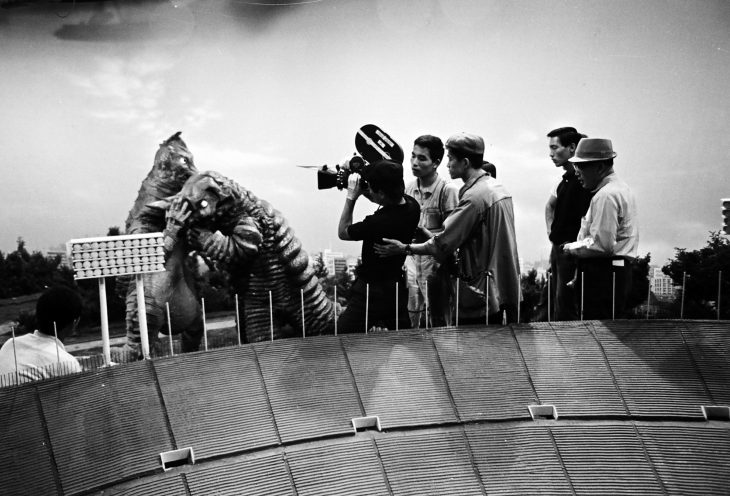
Tsuburaya Eiji (far right) overseeing the special effects studio while filming Demons Rise Again, episode 19 of Ultraman
© TSUBURAYA PRODUCTIONS
Children are very receptive to new things. They are also eager to absorb new information. The fact that new kaiju appeared on screen each week meant that there was new information to take in every time. Ultra Q brought with it a sense of speed that was faster than anything that had gone before it, and triggered a kaiju boom as a result.
Ooka: Children were focused on the monsters. The format however was based on regular people encountering extraordinary experiences every week. That meant stretching credibility from a dramatic point of view. In turn, that led to the idea to create a special team to battle against kaiju in the next series, Ultraman.
The result was Science Special Search Party, or Science Patrol for short. To add to that, the climax of the show saw one member of the team transform into a colossal hero to defeat the kaiju. That setup was something new.
Children loved the kaiju, and Ultraman gave them an even wider variety of monsters than Ultra Q, rampaging across their television screens. But just what sort of show was Ultraman intended to be? Three episodes from the series’ opening run provide a clear indication, distilling everything that the creators wanted to achieve. Episode two featured an alien called Baltan, an intergalactic castaway with no understanding of the concept of life. Episode three introduced Neronga, a monster that turned invisible by absorbing electricity. Episode five starred Greenmons, a kaiju that mutated into a carnivorous plant after being exposed to gamma radiation. Each character was completely different.
The reason for the existence of each monster (or alien) determined how the drama would unfold. Unlike Ultra Q, there was plenty of action from the main characters who made up Science Patrol too. They also had clear personalities (more than just characteristics), which made them accessible to children. The basic dramatic structure was incredibly simple, hurtling inevitably towards the appearance of Ultraman. Iijima Toshihiro, who directed these three early episodes, likened the appearance of Ultraman to a period drama, describing it perfectly as being like a “last stand” (build up to the climax).
With a running time of approximately 25 minutes, Ultraman packed in various elements of entertainment and became even more popular than Ultra Q. Viewing figures continued to climb, amidst a sense that the kaiju boom was really taking off. Following a six-month interval after the show ended, a third series called Ultra Seven began to air. Tsuburaya Eiji and the brand name Tsuburaya Productions were like a dream come true to children at the time.
As a result, fans soon became familiar with stories of Tsuburaya cutting special effects if they weren’t up to his standards, and relentlessly ordering scenes to be re-shot. Children put their trust in Tsuburaya, and in the Tsuburaya Productions brand, and would change channels so that they could get lost in the fantasy world. It was down to special effects to bring that fantasy world to life. That’s precisely why Tsuburaya approached shows with such an uncompromising attitude. Whenever he appeared in the preview room to check rushes (clips that had just been filmed) featuring special effects, a real sense of nervousness would descend amongst the other members of staff.
Ooka: Korakuen Amusement Park installed a special 360-degree “Circarama” special effects theater, and the job was given to Tsuburaya Productions. It showed Ultraman Ultra Seven: Great Violent Monster Fight, directed by Sagawa Kazuo. The full rush (rough cut) took place at Korakuen, because it was the only place where it could be screened. That was June or July 1969, if I remember correctly. The crew were all waiting for Tsuburaya to arrive. The moment he entered the theater, the entire atmosphere changed. There was a sense of tension, in case he might demand retakes. When the preview was over however, Tsuburaya simply said “that’ll do nicely,” and with that, the mood in the theater relaxed completely.
Tsuburaya Productions after Tsuburaya Eiji
Once located next to Toho Studios in Kinuta, Setagaya, the company’s headquarters have been relocated several times over the years, and are now based in Shibuya. These days, Ooka is the only person left at Tsuburaya Productions who actually knew Tsuburaya when he was alive. Ooka joined the company in May of 1969, in the last year of Tsuburaya’s life. As the kaiju boom had faded away by that point, it was the toughest time that the company had faced. Two years later, in 1971, The Return of Ultraman began airing, sparking a second kaiju boom and breathing new life back into Tsuburaya Productions. Tsuburaya didn’t get the chance to witness that happening however, as he passed away from angina brought on by bronchial asthma while recuperating at his second home on January 25, 1970.
In March 1975, the revived Ultraman series came to an end with Ultraman Leo. A third revival followed just four years later however, with the animated series The Ultraman. The following year, in 1980, the live action series Ultraman 80 made its first appearance. Despite having left Tsuburaya Productions, Ooka worked on the series as a special effects cameraman. In 1996, he played a key role as director of photography on Ultraman Tiga.
Ooka: Comparing now and then, there have been huge advances in terms of hardware, including changing media and digital technology. The things we’re doing on the software side of things however haven’t changed at all.
The fact that Tsuburaya Productions is still going is down to those first three series. That’s when the team was going through the process of trial and error under Tsuburaya. Their passion came through to the fans, and now fifty years later, they are still supporting us.
Everyone who saw the first Ultraman is now in their 50s or older. Nonetheless, they can still have conversations with their children in their 20s, and with their grandchildren, around the same shared subject of Ultraman. There’s never been anything like that before. That’s why we still have that same initial spirit and the passion to do our best to produce quality output, for new generations in the future. We will continue to put our all into creating series, so that we can get that across to viewers.
This year sees the release of a new Godzilla movie (Godzilla Resurgence) and a new Ultraman series (Ultraman Orb). Booms are temporary. Once they are over, they tend to be forgotten. The characters created by Tsuburaya Eiichi during the postwar era however, including Godzilla and Ultraman, continue to live on. They have grown into important content that is shared across the entire world. One of the reasons for this is that we live in a time when we need to think carefully about everything.
Translated from “Tokusatsu no Kamisama, Tsuburaya Eiji ga Nokoshita mono (The Master of Special Effects – The Legacy of Tsuburaya Eiji ― In conversation with Ooka Shinichi, President of Tsuburaya Productions),” Tokyo Jin, August 2016, pp. 50-57. (Courtesy of Toshi Shuppan) [August 2016]
